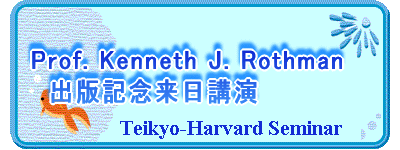Dear Reader,
It has been my good fortune to have recently visited Japan, and I was
pleasantly surprised not only by the vibrance of the people and the land,
but also by the vibrance of epidemiologic research in Japan. Gradually
Japan is asserting a stronger role in the field of epidemiology, and will
likely be a major locus for epidemiologic research in years to come.
In today's world, distances are shrinking while the pace of change is
increasing. Together these trends foster the introduction of new health
threats and exacerbate old ones, which will continue to challenge our health
and societal resources. We must prepare ourselves to meet these challenges.
This introductory epidemiology text is my attempt to bring the basic concepts
of epidemiology to a broader audience, among whom will be those who will
have to face the epidemics to come.
My favored approach has always been to rely on straightforward methods
in study design and data analysis to tackle epidemiologic problems. For
that reason, I emphasize the basic approaches to epidemiologic research,
rather than relying on unnecessarily complicated designs or mathematical
models that often befuddle both investigators and readers. I have noted
that in many epidemiologic curricula, students are taught to use multivariable
models before they have even a rudimentary understanding of basic epidemiologic
measures, such as rates and risks. Here my aim has been to introduce students
to basic concepts, use them to guide the design and analysis of epidemiologic
studies, and bestow the reader with the insights needed to evaluate the
suitability of more complicated and potentially dubious approaches. I hope
that the readers of this text, among whom may be both the next generation
of epidemiologists in Japan and those who will be working alongside them
in related fields, will find that it provides a firm foundation of useful
concepts and methods.
This summer I will be participating in the Teikyo-Harvard Seminars at
Teikyo University School of Medicine, to mark the publication of the Japanese
edition of Epidemiology :An Introduction. I hope that the seminar, along
with the translation of this book, will strengthen the collegial bonds
among epidemiologists in Japan and elsewhere.
Kenneth J. Rothman
Newton, Massachusetts
June 21, 2004 |

